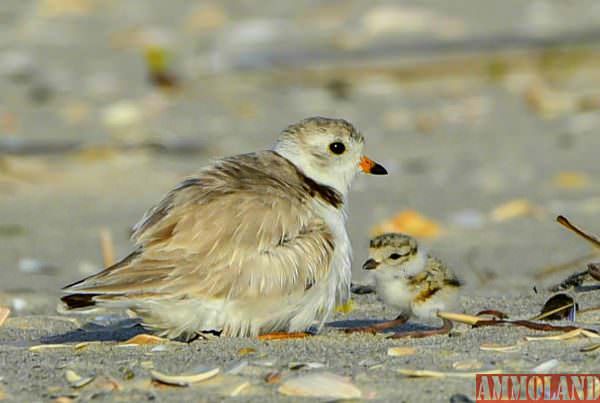

Trenton, NJ -(AmmoLand.com)- The pair of piping plovers nesting on the beach at Island Beach State Park (IBSP) successfully incubated their nest with four chicks hatching on July 2 and 3.
The nest, in the park’s Southern Natural Area, is the the first ocean side nest in more than 25 years and the first in the park in more than a decade. It is hoped this is an indication of a rebounding population after sharp declines between 2003 and 2014 of the federally threatened and state endangered piping plovers in New Jersey.
As is frequently the case with plovers, one chick was quickly lost to an unknown cause (most likely predation). As of Thursday, July 14, another chick had not been observed for three days, but since chicks can be notoriously elusive biologists are hopeful it is still alive. The remaining two were doing well, making some big movements this week. They had been staying in the general area of the nest but around the same time that the third chick disappeared, the brood headed south and moved approximately 1,000 meters, then over the past two days have moved back northward, covering almost the entire distance.
Piping plovers chicks leave the nest within hours of hatching, running between their primary feeding area at water’s edge to the cover found at the front of the dunes. This behavior makes them extremely vulnerable to predation or unsuspecting motorists driving on the beach, especially since the young are tiny and camouflaged – colored to blend in with the sand – and have a habit of freezing and crouching in the face of approaching danger.
IBSP staff, state Endangered and Nongame Species Program biologists and volunteers have worked together to monitor the brood (this is what we call the family after the nest has hatched) on a daily basis, in order to provide the most comprehensive data possible. Of note is that the chicks, within two days of hatching, were already using the intertidal area for foraging and have continued to use it throughout the week.
To protect the nesting area, IBSP staff erected a vehicle barrier and related signage and raked the beach to smooth out the deep ruts. The wrack line was left intact to allow for optimal foraging opportunity. A temporary restriction of sportfishing vehicles on the beach (pdf, DPF Site) is in place as per U.S. Fish and Wildlife Service requirements. Evidence of predator activity has been noted on all visits, including fox tracks and harassment of the brood by fish crows and herring gulls.
Plovers fledge in about 28 to 35 days, so the ultimate success of the nest is not guaranteed until they take flight and head south in September.
For more information on Piping Plovers and other beach nesting birds, including annual management reports, visit www.njfishandwildlife.com/ensp/beachnester_info.htm.
Also see The Wildlife Society’s post at www.wildlife.org/piping-plovers-return-to-new-jersey-beach-after-25-years.
About N.J. Division of Fish and Wildlife:
The N.J. Division of Fish and Wildlife is a professional environmental agency dedicated to the protection, management and wise use of New Jersey’s fish and wildlife resources. The Division is within the Natural and Historic Resources Group in the NJ Department of Environmental Protection under the direction of Assistant Commissioner Richard Boornazian.
For more information, visit: www.njfishandwildlife.com.
